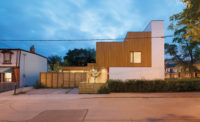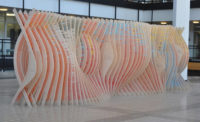Firm to Watch: Assemble




















Assemble is a London-based architecture collective that originated from the University of Cambridge's undergraduate architecture program, though it counts artists and philosophers among its staff.
In May, the phone rang in the studios of the London architecture collective Assemble. On the line was a representative for the Tate Modern, which issues Britain’s most prestigious artistic honor, the Turner Prize. Assemble was one of four finalists, the first design firm nominated since the prize’s establishment in 1984, said the caller. Alice Edgerley, a founding member of the firm, recalls the group’s initial reaction: “Are you sure you’ve got the right people?” The Tate had, indeed.
Assemble began as a group of undergraduates in the University of Cambridge’s architecture program eager to create a communal gathering space, a place that would be more than an inert architecture pavilion. The young architects noticed that disused gas stations—more than 4,000 of them—riddled London neighborhoods. Without a budget or a formal client, the collective converted one of these sites into a sidewalk cinema in 2010, called The Cineroleum. With the help of more than 100 volunteers, they made their own flip-up seats and a shimmery curtain fabricated from roofing material, and screened films such as The Night of the Living Dead and Barbarella for £5 (beer, £2). These screenings sold out every night for the cinema’s month-long run.
For its next project, Folly for Flyover, Assemble took the space beneath the underbelly of a freeway and designed a performance venue, modeled after the neighborhood’s traditional pitched-roofed brick buildings. In lieu of bricks they strung wood blocks together like love beads, and supported them with metal poles. They partnered with the Barbican Arts Center and local organizations for programming, and staged performances for more than 40,000 visitors over the course of the summer.
Assemble has taken on other community-oriented projects, including a town square in the New Addington neighborhood of South London, and a playground in a tough region of East Glasgow where children can control their built environment.
In 2013, Assemble started one of its most ambitious jobs yet, the Granby Four Street project, for which the collective partnered with the community of Toxteth in Liverpool, to revitalize a series of neglected housing blocks. Building on a decade of work by residents and a local land trust, Assemble helped devise a plan to rebuild dilapidated early 20th-century housing stock and to design public space. The project caught the eye of the Turner Prize jury. The winner will be announced on December 7.
Assemble works in Sugarhouse Studios, a self-designed workshop in East London. Additional space in the front called the Yardhouse is rented to resident carpenters, artists, and furniture designers. The collective has developed a nonhierarchical way of working based on an internal freelance system. Half of the money goes to the collective itself, while the rest is divvied up among those working directly on the project.
On a recent Monday evening, the buzz of saws could be heard as the group prepared to hold its weekly meeting to discuss upcoming work—a project for the Chicago Architecture Biennial, an art center for Goldsmith College (its largest project to date), and work on another street in Toxteth.
“Initially, the nomination made us look at our work in a different light, but now we are back to how we work,” Edgerley says. “If the story of Granby Four Street can be shared as much as possible, that’s great.”
















